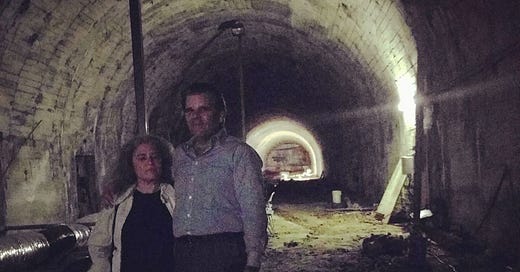The Spring Street Spring Reveals Itself
everyone wants to know about the secret Prohibition tunnels of Downtown L.A., but truly dedicated history geeks ask about the lost creeks
Gentle reader,
We’re grateful that you’ve signed up to receive this special subscriber’s edition of the Esotouric newsletter, launched to provide us with some income while our tour business is shuttered during the pandemic. Thank you for believing in us!
Here’s a bit of lesser-known local lore that we hope will give you a thrill.
Los Angeles was founded near the River, at the place where the Tongva people had lived and traded for generations. They called their home Yangna.
As the Spanish village and later Anglo city displaced the old ways and people, residents lost sight of the natural power of water to shape the landscape.
But when you study local history, you begin to see water’s subtle influence on familiar places.
The park now known as Pershing Square (Block 15 of the Ord Survey), for instance, became a public space in 1866 because Angelenos considered it an unsuitable place for a home.
Writing in the Annual Publication of the Historical Society of Southern California in 1911, J.M. Guinn explains, “There was [a] reason why settlers did not locate on lots on Olive and Charity (Grand Avenue) Streets near the base of the western hills. The Arroyo de Los Reyes… crossed Olive Street north of Sixth and cut a corner off the prospective park, then it zigzagged in a deep channel through the blocks between Hill, Olive and Charity Streets down to Washington Street. In the Spring of the year there was considerable water in it and innumerable frogs nightly held concerts along its reedy brink. As the season advanced, millions of mosquitoes hatched in the stagnant pools of the arroyo of the kings and made night a horror to the dwellers on its banks. These appurtances to real estate in that locality made it undesirable for first-class residences.”
The pseudoscientific miasma theory of disease associated such swampy places with infection. Fine for an occasional afternoon’s stroll, accompanied by a cold draft sarsaparilla, but you wouldn’t want to sleep there.
Several times over the last decade, we’ve had the great good fortune to be granted access to the holy grail of Downtown Los Angeles urban exploration sites: the sealed off Pacific Electric interurban railway tunnel under the Subway Terminal Building at 417 South Hill Street.
The first time we visited, we noticed the wetness of the tunnel floor and the constant hum of pumps. On our second visit, soon after a small earthquake, we saw clear evidence of flowing, rising water. The Spring Street Spring, or more formally the Arroyo de Los Reyes, was alive!
Keep reading with a 7-day free trial
Subscribe to News from Esotouric's Secret Los Angeles to keep reading this post and get 7 days of free access to the full post archives.




